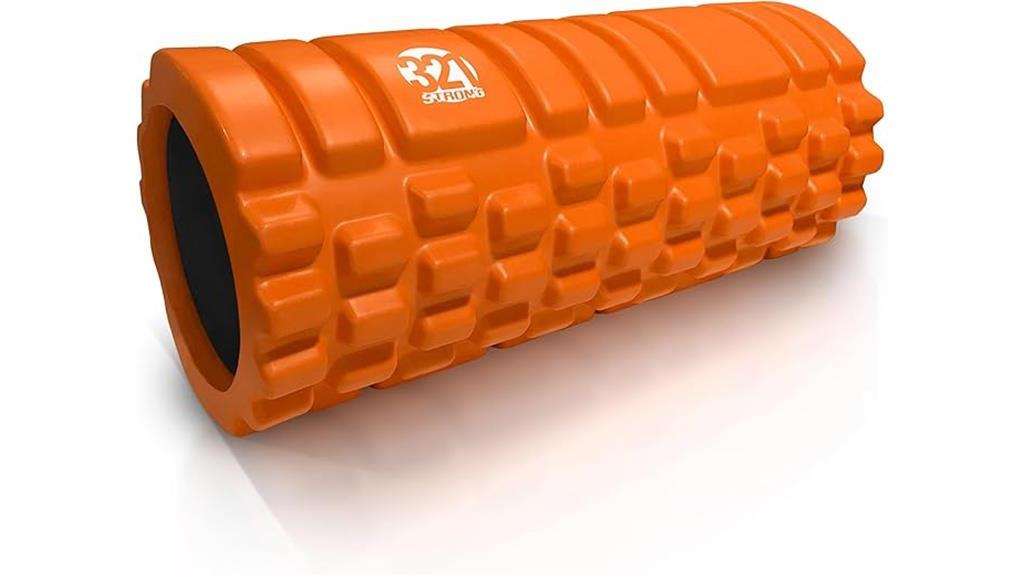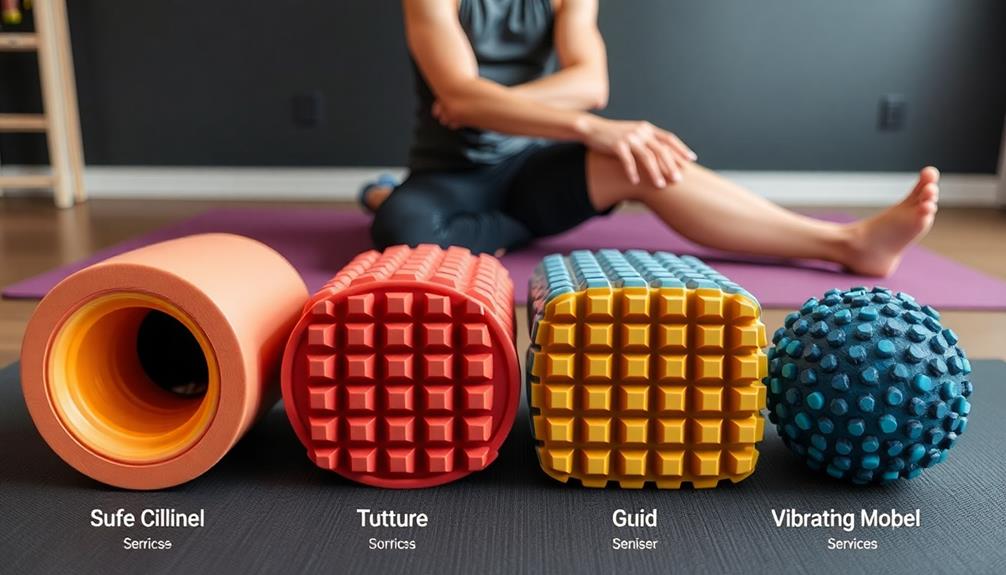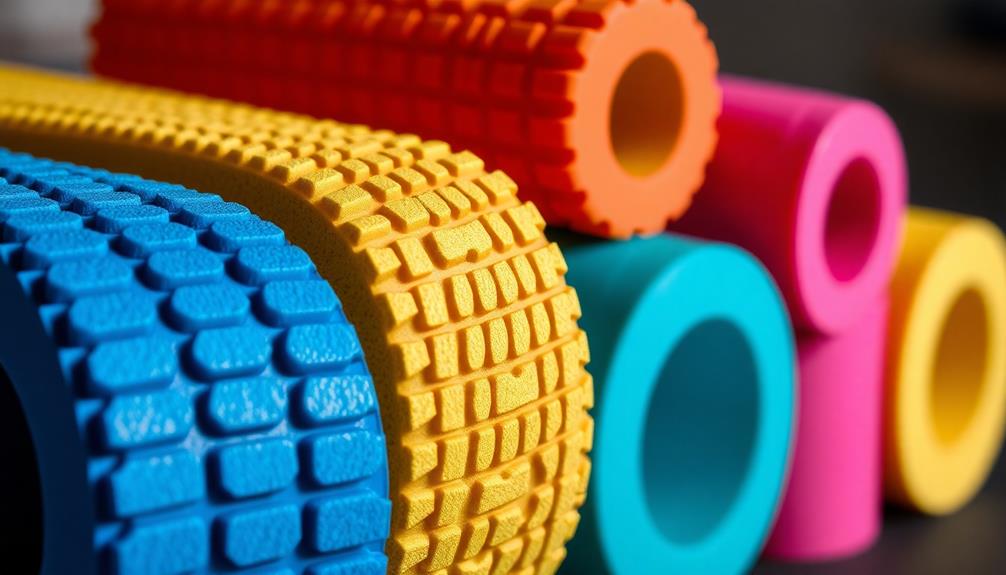You've probably heard about foam rollers and their benefits, but with so many options available, it can be challenging to choose the right one for your needs. Whether you're looking to soothe sore muscles, create perfect curls, or enhance your yoga practice, there's a foam roller designed for you. In this discussion, we'll explore three top-rated foam rollers that stand out in their respective categories. By understanding the unique features and applications of each, you'll be better equipped to make an informed decision. Let's take a closer look at what makes these foam rollers exceptional and how they can improve your daily routine.
Yes4All High-Density Round Back Roller Foam for Yoga and Pilates

The Yes4All High-Density Round Back Roller is a great pick if you want a sturdy foam roller that can handle tough workouts. It's made of 100% EPP foam and comes in 12, 18, 24, and 36-inch sizes, all 6 inches wide. This roller works for people up to 300 lbs, so it's good for trainers and advanced users.
You can use it for self-massage, recovery after exercise, and physical therapy. It works well for yoga, Pilates, stretching, and warm-ups. People say it helps with back, hip, and shoulder pain and loosens tight muscles. The dense, one-piece build means it lasts a long time. Plus, it's small and light, so it's easy to use at home. You can return it within 30 days or get a 1-year warranty if there are issues.
This roller is best for athletes, fitness fans, and anyone who wants deep massage and pain relief through self-massage and therapy.
The good:
- Super sturdy and lasts a long time, even for people up to 300 lbs
- Comes in different sizes to fit your needs
- Works for all kinds of exercise and stretching
The not-so-good:
- Might be too hard for beginners or if you have sensitive muscles
- Costs more than basic foam rollers
- Only comes in a few colors
Conair Foam Hair Rollers (48 Count, Assorted Colors)

Conair's 48-count assorted foam rollers are a great choice if you want a versatile, comfortable way to style your hair. These rollers have a self-grip design, so you don't need any pins or clips. They make it easy to create curls, waves, and updos with lots of volume. The set also comes with a handy clear zippered storage case.
Many people find these rollers comfortable enough to sleep in, so you can style your hair overnight. They work well for making tight, defined curls and giving your hair more volume. Some customers say the results last a long time, but others have had problems with dryness or curls falling out. To get the best results, look up tips for the specific vintage hairstyles or looks you want to achieve.
These hair rollers are best for:
- People who want an easy, versatile way to style their hair at home
- Those looking for a comfortable option that doesn't need pins or clips
Pros:
- Easy to use and comfortable enough to wear overnight
- Can create many different styles, including curls, waves, and volume
- Comes with a convenient storage case
Cons:
- Reviews are mixed on how well they work and how long the curls last
- Some users have had issues with hair dryness or breakage
- Might not work as well for all hair types
321 STRONG Foam Roller for Deep Tissue Massage

The 321 STRONG Foam Roller is great for deep tissue massage. It's perfect for athletes, fitness fans, and anyone looking to relieve muscle pain. This medium-density roller feels like a therapist's hands, targeting different muscle groups. It's lightweight and easy to use, making it ideal for both beginners and experienced users.
The roller's unique triple grid 3D massage zones offer instant benefits. It helps with muscle pain, improves flexibility, and boosts blood flow. Use it for warm-ups, cool-downs, and various exercises. It's versatile enough to target leg, arm, and foot muscles. As a bonus, you'll get a free eBook with helpful tips and information. Some users mention occasional squeaking, but most say it's durable and performs well. Whether you're an athlete, yogi, or therapy patient, this foam roller is a valuable tool for your fitness routine.
Best for: Athletes, fitness enthusiasts, and people who want muscle pain relief and better flexibility through deep tissue massage.
Pros:
- Works well for different muscle groups with triple grid 3D massage zones
- Lightweight and portable, suitable for beginners and experienced users
- Includes a free eBook for extra guidance
Cons:
- Some users report squeaking during use
- Mixed opinions on the roller's width and intensity
- May be uncomfortable for some users, especially beginners
Factors to Consider When Choosing Foam Rollers

When selecting a foam roller, you'll need to weigh several key factors to make sure you get the right one for your needs. These factors include the density and firmness levels, size and portability options, surface texture variations, material and durability, and compatibility with your intended use. By evaluating these aspects, you'll be better equipped to choose a foam roller that meets your specific requirements and helps you achieve your fitness or recovery goals.
Density and Firmness Levels
Foam rollers come in different densities and firmness levels to suit various needs. Soft, medium, and firm options are available, each designed for specific user requirements and experience levels.
If you're new to foam rolling, start with a softer roller. This provides a gentle massage and allows you to get used to the practice without putting too much pressure on your muscles. As you become more comfortable, move on to medium-density rollers for a balance of comfort and effectiveness.
Firm foam rollers are ideal for athletes and those looking for intense muscle relief. They provide a deep tissue massage, targeting specific muscle groups to improve flexibility and speed up post-workout recovery. High-density rollers are great for enhancing range of motion and addressing tight muscles.
Choosing the right density is key to getting the results you want. Think about your experience level, pain tolerance, and specific muscle needs when picking a foam roller. Keep in mind that the firmness level directly affects the intensity of the massage, so find the right balance for your body.
Size and Portability Options
Choosing the right foam roller size and portability is easy when you know what to look for.
Length: Foam rollers range from 12-36 inches long. Shorter rollers (12-18 inches) target specific areas and are easy to take with you. Longer rollers (24-36 inches) are great for full-body rolling and extra stability during exercises.
Diameter: Thicker rollers (5-6 inches) give a gentler massage, while thinner ones offer more intense pressure.
Portability: If you're always on the go, choose a lightweight, compact roller that's easy to pack.
Storage: Think about where you'll keep your roller. If space is tight, a smaller model that fits in a closet or under the bed is best.
Versatility: Textured rollers provide a deeper massage, while smooth ones are better for gentle stretching and relaxation. Pick one that meets your needs.
Surface Texture Variations
Surface Texture Options for Foam Rollers
When picking a foam roller, the surface texture is just as important as the size and portability. Different surface textures offer unique benefits and experiences.
Smooth Rollers
New to foam rolling? Try a smooth roller. They provide even pressure and are great for general use and relaxation.
Textured Rollers
Want a more intense massage? Go for a textured roller with ridges or knobs. They target specific muscles and increase blood flow, perfect for athletes or those with persistent knots.
Contoured Rollers
Contoured rollers offer the best of both worlds. They have different zones for specific muscle relief and flexibility. Choose these if you want to target multiple areas or need a customized experience.
Material and Durability
When picking a foam roller, pay attention to what it's made of and how long it will last. Choose one that can handle regular use without breaking down. EPP foam rollers are a good choice since they're tough and resist wear.
A solid core is key for stability and support during use. It keeps the roller from losing its shape over time. Medium to high-density rollers work best for deep tissue massage and helping muscles recover.
Firmness matters too. Pick a level that matches what you need for relaxing muscles and easing pain. Some rollers have textured surfaces or 3D massage zones that target specific areas and make rolling sessions more effective.
Intended Use Compatibility
When choosing a foam roller, compatibility is essential. Consider your needs and fitness level to ensure you get the most benefit. Athletes seeking deep tissue massage should choose a firmer roller to target tight muscles. Beginners or those with sensitive muscles may prefer a medium-density roller.
Think about how you plan to use the roller. Different purposes, such as pre-workout warm-ups, post-workout recovery, or physical therapy, may require specific features. If you're using the roller for yoga or Pilates, a softer, more versatile option might be best.
Consider which muscle groups you'll target. Some rollers are designed for specific areas like the back or feet. A versatile full-body roller is a good choice if you're targeting multiple areas.
Price and Warranty Considerations
Price and warranty are key when buying a foam roller. Prices range from cheap to expensive, with different features. Compare price and quality to get the best value.
Don't forget about the warranty. It protects you if there are any problems. Read the warranty details to see how long it lasts and what's covered. Some brands have longer warranties or guarantees.
To make a smart choice:
- Set your budget
- Look at different foam rollers in your price range
- Compare features and quality
- Check the warranty for each one
- Think about long-term value of pricier, sturdier rollers
Frequently Asked Questions
Can Foam Rollers Help With Cellulite Reduction?
While foam rollers can't directly eliminate cellulite, they may help improve its appearance. You'll see benefits by increasing blood flow, breaking up fascia, and promoting lymphatic drainage. However, don't expect miracles; results vary for everyone.
How Often Should I Replace My Foam Roller?
You should replace your foam roller every 6-12 months, depending on usage. If you're using it daily, lean towards the 6-month mark. Look for signs of wear, like flattening or cracks, to determine when it's time for a new one.
Are Foam Rollers Safe to Use During Pregnancy?
You can generally use foam rollers during pregnancy, but consult your doctor first. Avoid rolling on your stomach and lower back. Use gentler pressure and focus on areas like legs and upper back. Always listen to your body.
Can Foam Rolling Be Harmful if Done Incorrectly?
Yes, foam rolling can be harmful if done incorrectly. You'll risk injury if you roll too aggressively, target sensitive areas, or use improper technique. Understanding correct methods and paying attention to your body's signals are crucial when rolling.
Are There Any Alternatives to Foam Rollers for Muscle Recovery?
You've got options beyond foam rollers for muscle recovery. Try massage balls, stretching bands, or percussion devices. Don't forget about yoga, cold therapy, or even professional massages. Experiment to find what works best for your body.

